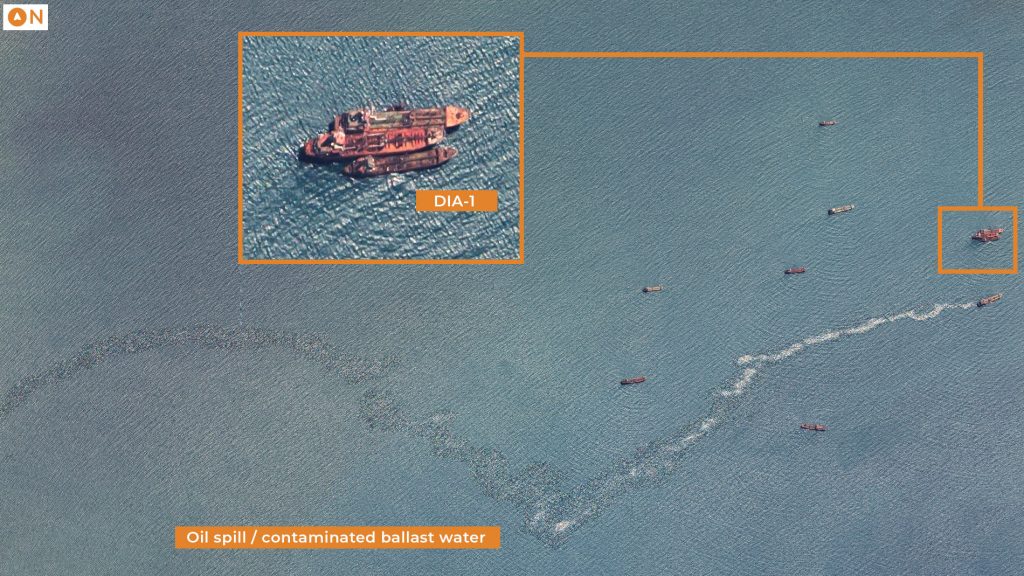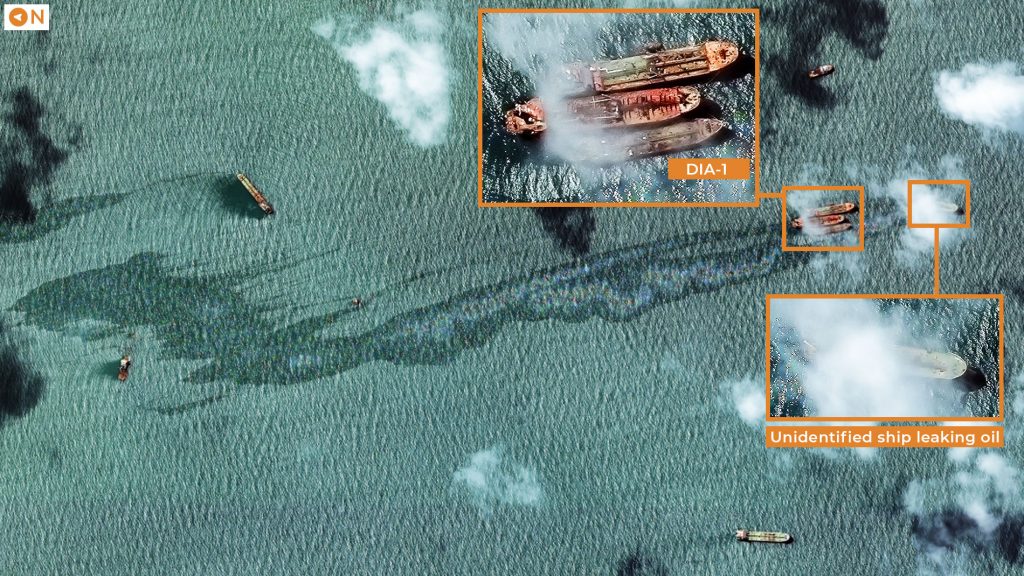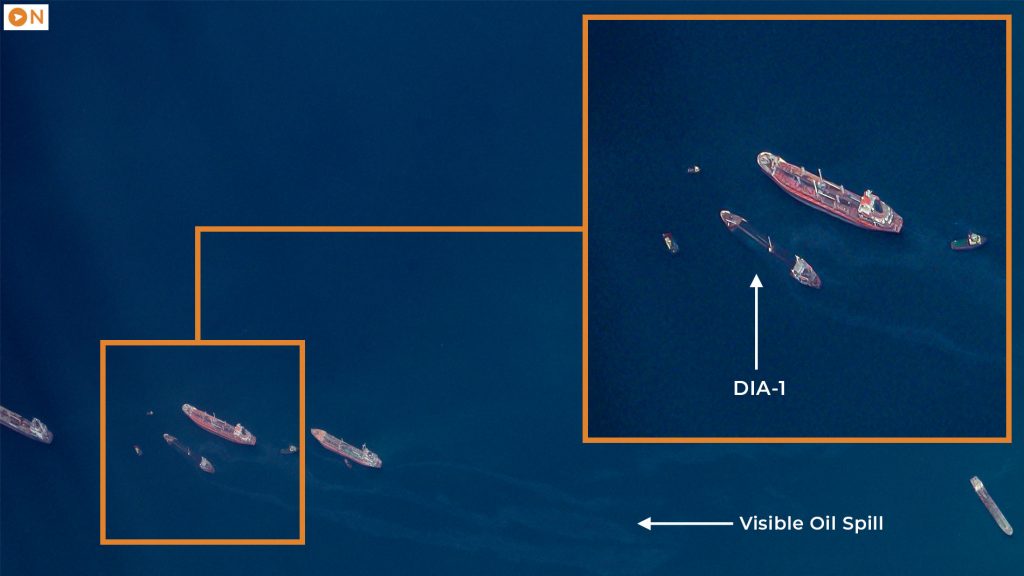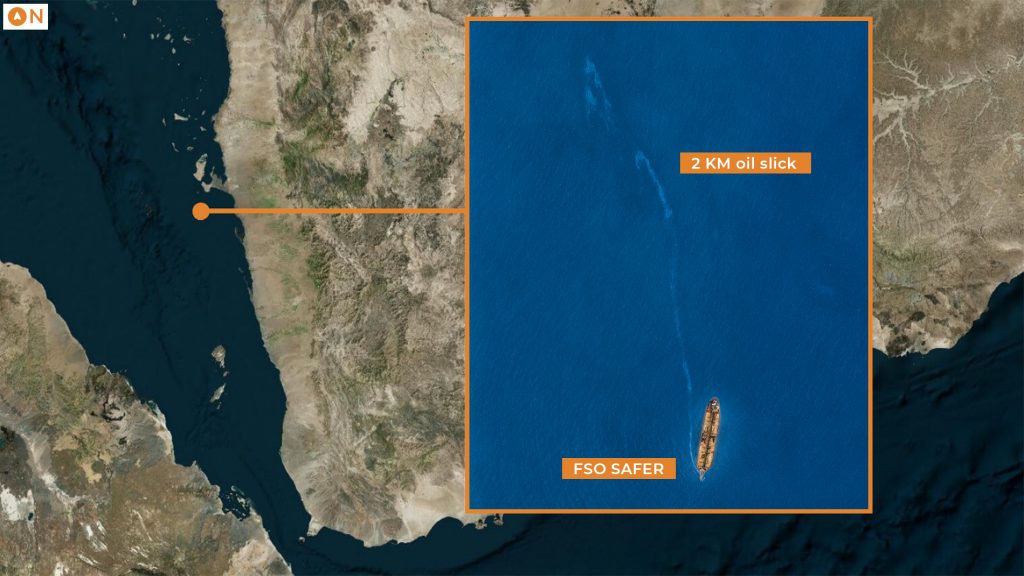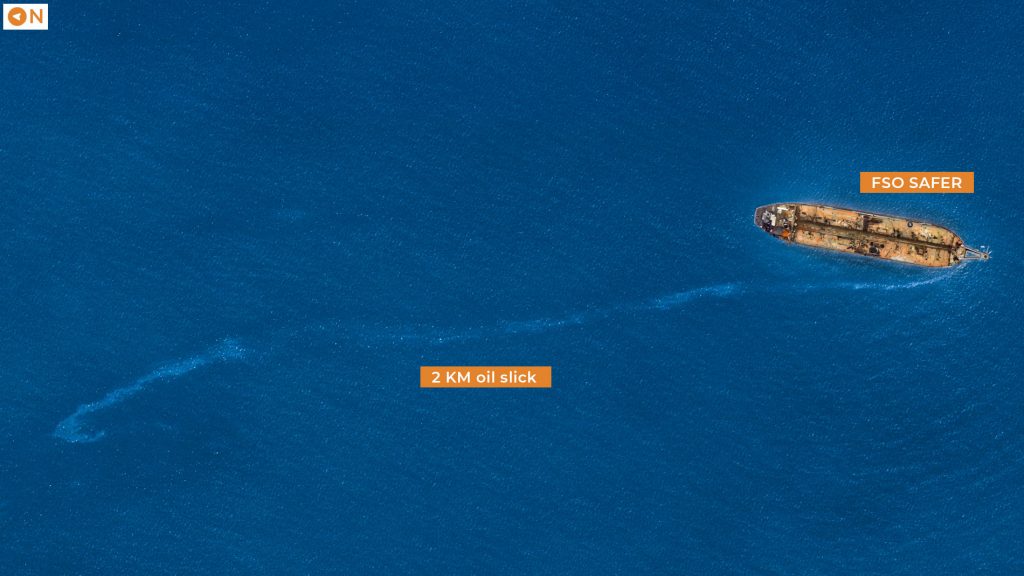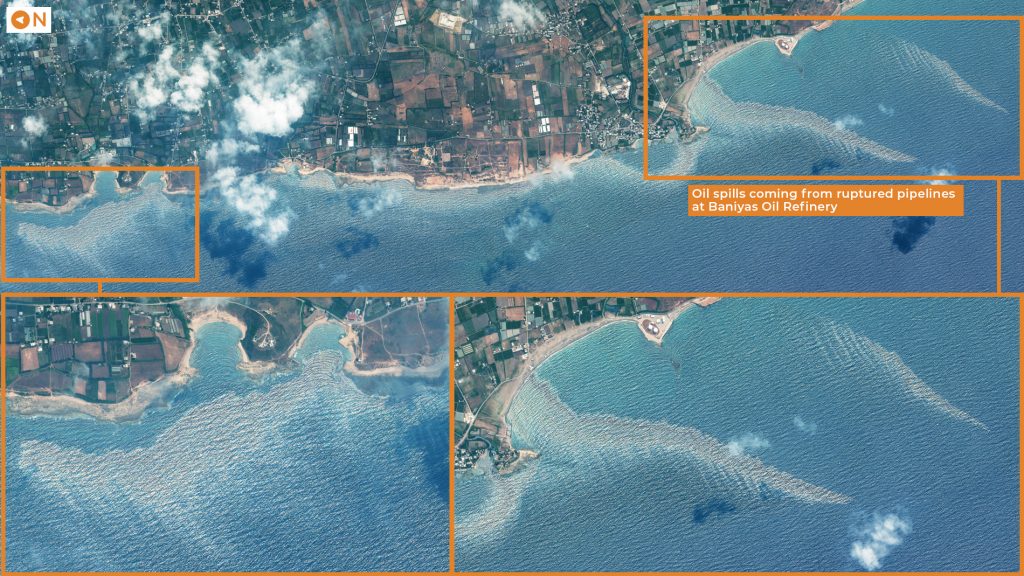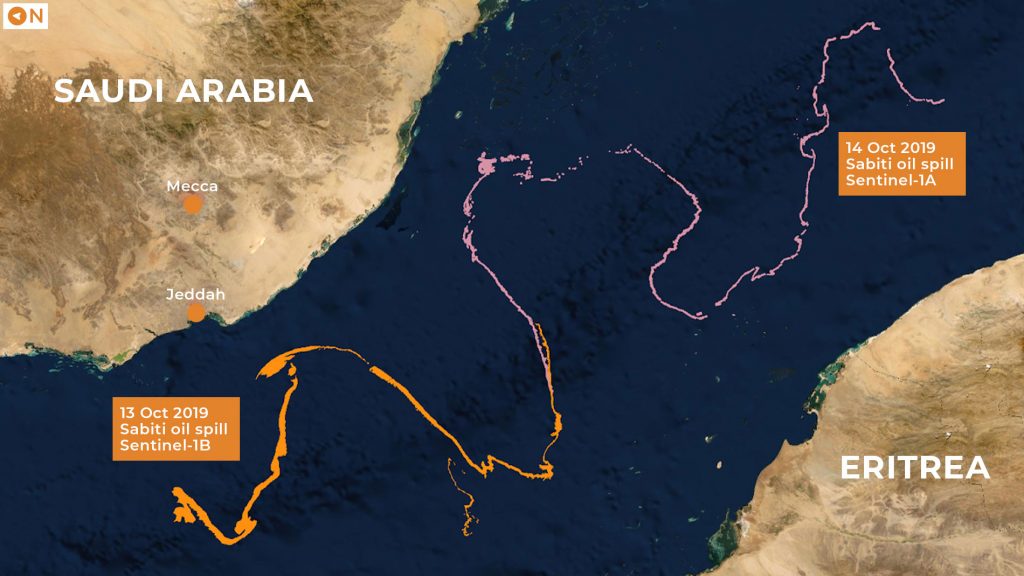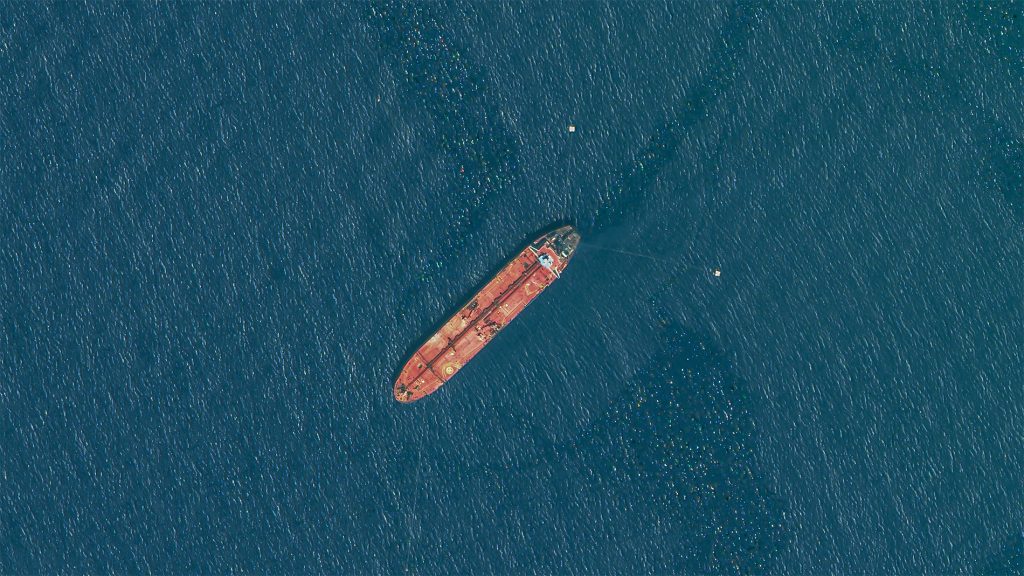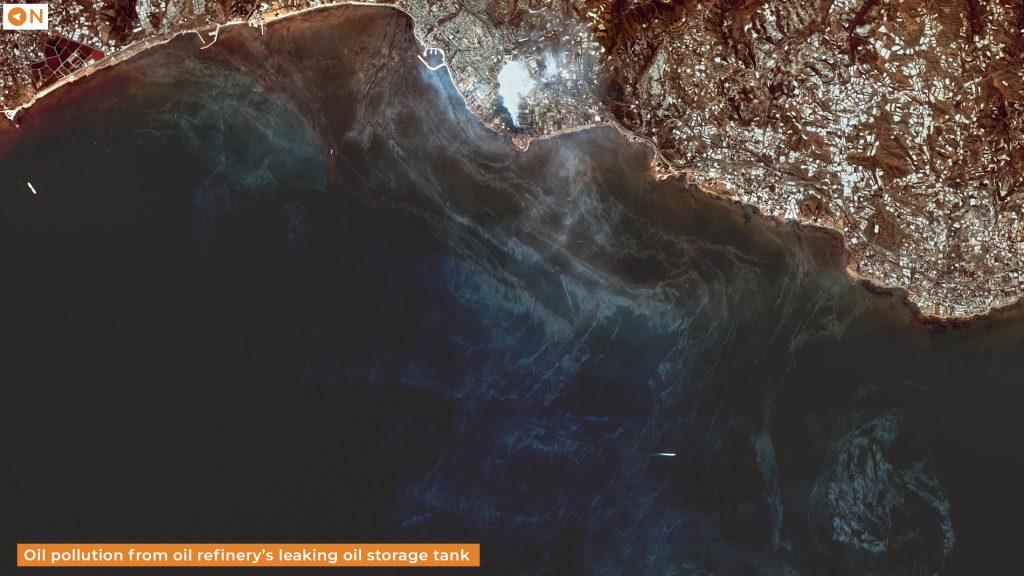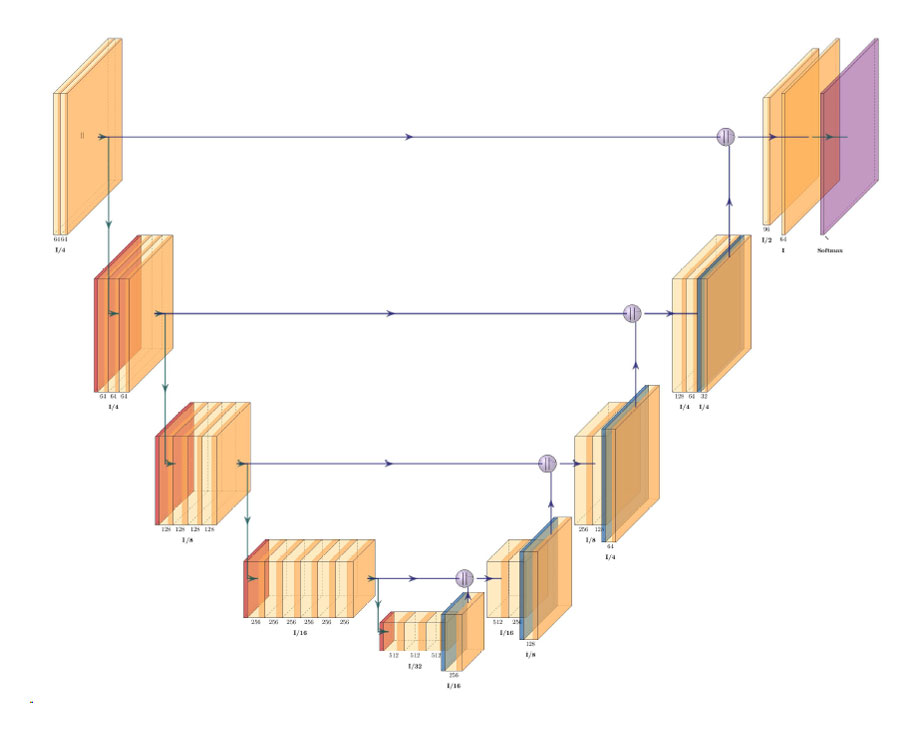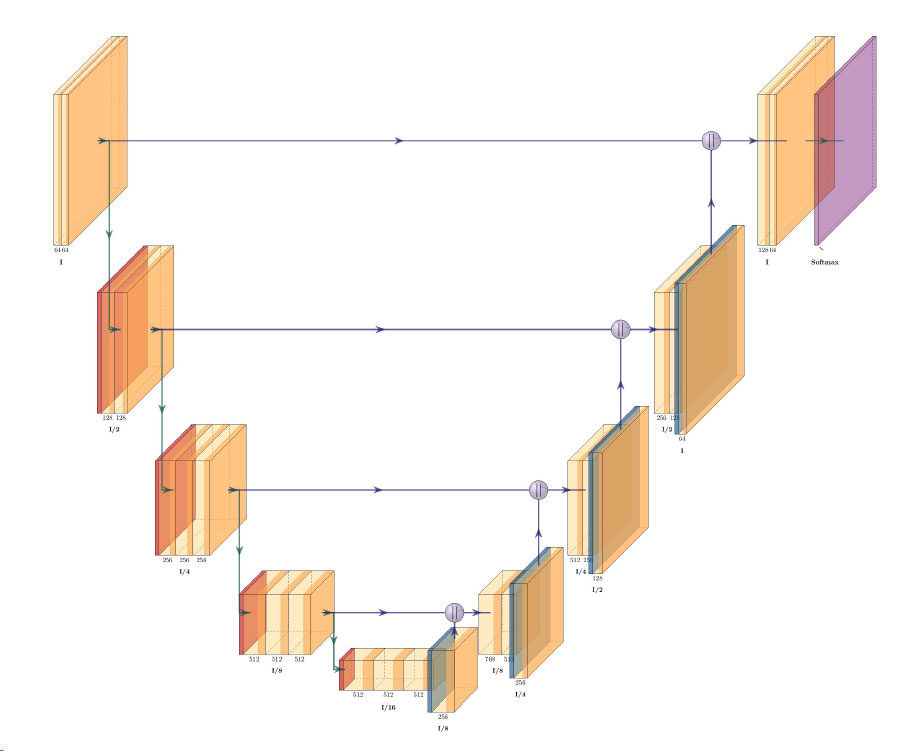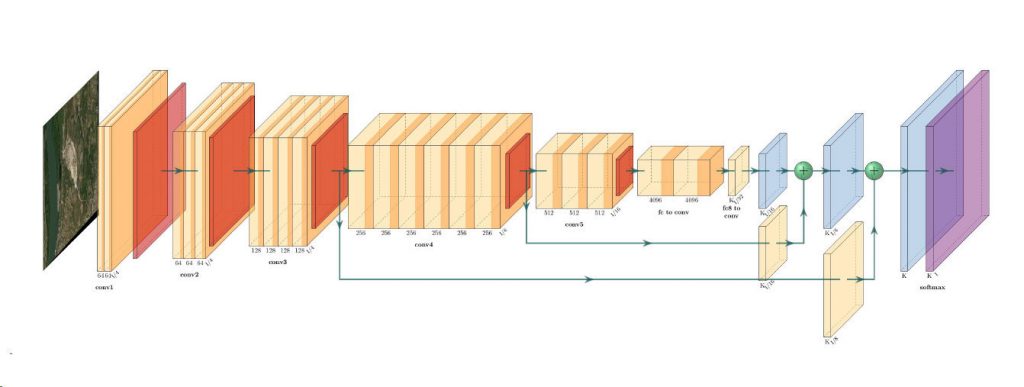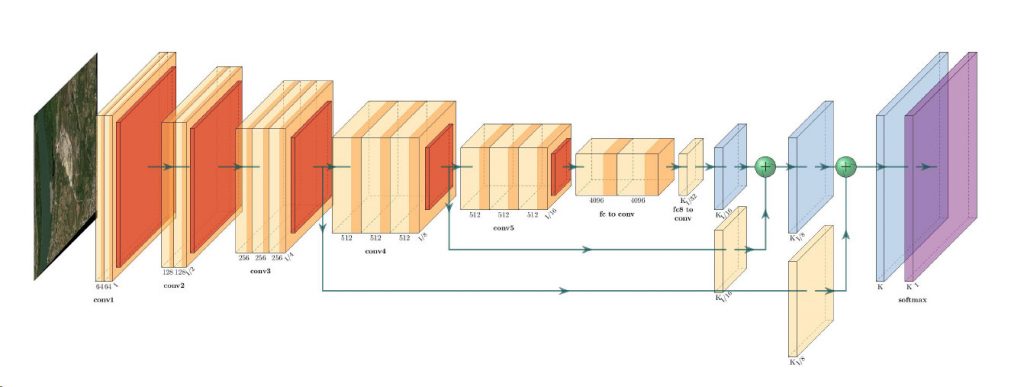Increasing Situational Awareness of Conflict Linked Oil Pollution with VHR Satellite Imagery
- Skye Boag, Marketing Manager at European Space Imaging
- and Wim Zwijnenburg, Humanitarian Disarmament Project Leader at PAX & Contributor for Bellingcat
Very High Resolution (VHR) satellite imagery is often used as a source of truth to verify what is happening on the ground in hard to reach, remote and/or dangerous locations. The better the resolution, the clearer the image, which can be a critical piece of information when trying to identify particular features, such as the name of a ship. In regards to maritime and the environmental impacts this industry can impose, VHR satellite imagery can be a useful tool for monitoring and tracing oil pollution on the seas surface, identifying those responsible for the pollution and assisting emergency services in coordinating efficient clean-up efforts.
In conflict zones, VHR Satellite imagery can be used prior to a disastrous event for strategic planning. Monitoring abandoned or conflict sieged ships containing pollutants on board provides valuable information for change detection that could decrease the risk of a catastrophic oil spill with the potential to devastate marine ecosystems, halt local fishing industries causing a major economic strains, as well as limiting food and fuel imports to citizens living in the surrounding cities.
European Space Imaging has joined forces with Wim Zwijnenburg, Humanitarian Disarmament Project Leader at PAX to investigate current environmental concerns from conflict-linked oil pollution incidents in the Gulf of Aden near Yemen and the Mediterranean Sea near Baniyas, Syria by analysing VHR satellite imagery from the Maxar WorldView constellation.
Over the last two years, Yemeni territorial waters in the Gulf of Aden and the surrounding Red Sea have been exposed to numerous oil spills from ships and abandoned, attacked or illegally seized oil tankers and thereby causing significant strain on marine life, biodiversity and the citizens living along the coast. The Red Sea is a major global shipping route for oil and other trades and these incidents not only have an enormous environmental impact but also disrupt the world’s economy.
The Mediterranean Sea off the coast of Baniyas, Syria, has experienced numerous incidents of oil pollution, both catastrophic and minor, in recent years. This has resulted in ecological disasters that have affected surrounding countries including Israel and Lebanon. Such pollution adversely affects marine life, coastal ecosystems and citizens living nearby.
Ship Pollution and the Dilapidated DIA-1, Aden Yemen
The port of Aden is the main economic and transport hub in Yemen for containers and oil ships. After the escalation of the war between the Houthis, an armed group, and the government of Yemen in 2015, the port was heavily shelled, and subsequent fighting left its scars on the city, but also rendered many marine services useless. This resulted in lack of maintenance anchoring vessels, with many of them abandoned.
Visiting oil tankers often dumped oil and fuel, which has been caught via very high-resolution imagery throughout the years. In the image below, an oil slick is spotted coming from a cargo ship heading towards Aden’s port on June 4, 2021. The spill stretched over 5km long and went on for a few days, as verified by a WorldView-3 image captured on 7 June 2021. We were unable to identify the name of the ship as the Automatic Identification System (AIS) transponder was turned off.
On July 18 2021, the DIA-1 oil tanker, a dilapidated oil tanker that had been anchored off the port of Aden in Yemen since 2014 started taking water and sunk, leaking diesel oil that it was storing. The tanker was built in 1975 in Japan and had a carrying capacity of 5000 deadweight tons. After the ship capsized, an oil spill consisting of diesel oil quickly dispersed across the port, and polluted the beaches over a stretch of 20 kilometers, killing fish and threatening the ecosystem of the Al-Huswah natural reserve, the only nature reserve in the city.
The FSO Safer, west of Yemen
The FSO Safer is a 45 year old abandoned oil tanker that is currently anchored near the strategic western Red Sea port of Al-Hudauyah, approximately 4.8 nautical miles off the coast of Yemen. The vessel is loaded with more than 1 million barrels of crude oil and is at risk of rupture or exploding; an event that would cause devastating environmental damage to Red Sea marine life and significantly jeopardise international shipping routes. According to a recent publication by scientists in Nature, the public health risks from such a disaster will be severe and widespread, affecting daily water and food supplies to roughly 10 million people, and damaging almost 100% of all the Red Sea fisheries. Timely monitoring of incidents is key for early warning. Due to the ongoing conflict in Yemen, all production and export operations related to this vessel have been suspended and the vessel has remained under the control of Houthi forces since 2015, with its structural condition declining and thus increasing the risk of a potential environmental disaster.
Over the course of the years, the massive tanker has witnessed several oil pollution incidents with, as reported by the website Tankertrackers, noting small spills in June and October 2020. Tracking those incidents in absence of an independent party is vital to raising alerts to avoid a catastrophic event. On the 14th of July, Sentinel-1 radar imagery indicated an oil spill of 9km long, yet was not clear enough to precisely tell if this was oil. Using a VHR image taken on July 15, 2021, a clear oil slick is visible coming from the hull of the ship, stretching out 2km northwards.
Oil Pollution off the Coast of Baniyas, Syria
Syria’s oil industry took a heavy hit during the war, as the Syrian government lost control over the major oil fields in the east of the country. Before the war, the crude oil was transported through pipelines from the east to the city of Homs in the west, where Syria’s main refinery is located, with an estimated 400,000 barrels per day production. But the loss of access to the main oil fields in Deir ez Zor resulted in dependency of oil import. With Iran as its main supplier, Syria now imports crude oil through the port of Baniyas, where there is a large oil storage facility with dozens of large and small oil storage tanks and seven single buoy mooring stations (SBM’s): underwater pipelines that connect with anchored tankers. It is here that Iranian oil ships load or off-load their cargo. These ships often contribute to pollution to the local area by discharging contaminated ballast water and other oil products, as was documented by PAX in three-year long earth-observation exercise using various satellites.
In June 2019, explosions ripped open the underwater oil pipelines leading to the SBMs. Tons of oil gushed out into the open water, causing a 20km long spill, as was documented by Bellingcat using various satellite providers. In this article we will use VHR for the first time to show the oil spill at the Baniyas beacher in the days following the sabotage attacks.
Later on 11 October 2019, an Iranian owned oil tanker, Sabiti, was headed towards Baniyas when it was attacked in the Red Sea off the Saudi Arabian coast causing two storage tanks on the vessel to explode and leak unknown quantities of oil into the Red Sea. The spill extended more than 1200km causing not only environmental damage, but also shippings costs, as well as insurance premiums, to rapidly rise. The spill was captured with Sentinel-1 and shows the extent of the oil in the Red Sea.
Below is a clear image of the SAM-121, a 274 meter long Iranian oil tanker off-loading crude oil near Baniyas Port on 27 July 2021. It was one of three oil tankers captured in the area by satellite imagery with a combined total of 2.6 million barrels of oil on board the three ships. Media reports suggested that the ships were carrying a low-quality heavy fuel oil, used in power plants and similar applications, and was originally destined for Lebanon.
Things went from bad to worse in Banyias. After this event, Syrian officials reported that a tank filled with 15,000 tons of fuel had been leaking since August 23 at an oil refinery located close to the port of Baniyas. Satellite imagery was used in this event to estimate the size of the spill, verifying that the spill was in actual fact larger than originally estimated and stretched over 800 km. At the time of the event, there were grave concerns of the flow direction of the spill with fears that it could reach as far as Cyprus and Turkey in a short amount of time. The Baniyas refinery is the main source of Syrian fuel products and is essential to keeping the country powered. A satellite image taken on August 28 shows the oil gushing from the oil refinery’s leaking oil storage tank into the bay at Baniyas.
This was the second major oil spill in the eastern Mediterranean in 2021. In February, an oil spill off the coast of Israel devastated the country’s beaches and left tar deposits across the Lebanese coast.
Conclusion
Very High Resolution satellite imagery is a critical tool in detecting and monitoring illegal oil discharges from ships, as well as aiding the subsequent clean up efforts. It can assist in oil spill mapping of both tactical and strategic countermeasures, slick detection, trajectory determination and surveillance, as well as providing legal evidence for aiding law enforcement. To respond to an oil spill effectively, those involved in the response operations require accurate and timely information on the location, the quantity and characteristics of the oil spilled and information of the areas likely to be impacted by the spilled oil. Surveillance is imperative to providing this ‘situational awareness’ during an oil spill response operation. As the ocean is large, this can be rather difficult, even more so in waters that are prone to conflict. Surveillance via remote sensing provides a safe solution to challenge. Whilst large oil spills can be seen in most sensor resolutions, the smaller spills tend to be more frequent and are harder to detect and that is where VHR satellite imagery becomes invaluable.
About PAX
PAX means peace. PAX brings together people who have the courage to stand for peace. Together with people in conflict areas and concerned citizens worldwide, PAX works to build just and peaceful societies across the globe. PAX works on the basis of two central values of peace in conflict areas: human dignity and solidarity with peace activists and victims of war violence. Their central values lead to a distinct vision of peace and security. In their peace work, they are guided by the concept of human security; the protection and security of civilians leads their responses to conflicts. For more information, visit their website.
Special Thanks to Tanker Trackers and Twitter user @obretix for assisting with information relating to specifics of the ships mentioned in this article.
Related Stories
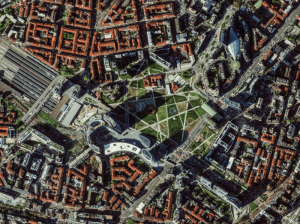
Europe’s Green and Digital Transformations with 25 Years of VHR Satellite Archive Data
Planning Europe’s future without knowing its past is impossible. The European Green Deal, Horizon Europe, the EU Biodiversity Strategy for 2030 and other policies all demand one thing: evidence. Not just today’s data, but years of history that show how our cities, forests, and coastlines have changed.
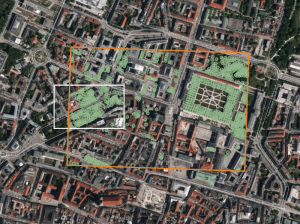
AI Uses 15 cm Satellite Images to Cut Costs and Increase Scalability in Forest Management and Urban Forestry
Forest managers across Europe face an impossible task: monitor millions of hectares with shrinking budgets while meeting increasingly strict EU environmental targets. But with the rise of AI and satellite technology, they now have new solutions at their disposal – smarter, cheaper, and more scalable – to monitor forest health, automate tree inventories, and plan sustainable logging. In this article, we introduce one of these solutions: an AI forestry algorithm developed by Arboair using 15 cm satellite data from EUSI.

GEOSeries: Extracting Insights From High Resolution SAR Imagery for Time-Sensitive Analysis
In this webinar, industry experts and advanced users of Umbra SAR data showcase how they transform SAR imagery into actionable insights in real-world mapping, monitoring and intelligence applications. See how NV5 and Umbra leverage ENVI SAR Essentials for advanced processing with time-efficient results, converting analytics into valuable intelligence.
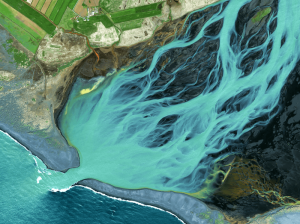
Using Satellite Imagery to Build Water Resilience Across Europe
Water across Europe is facing severe pressure. Climate change, urbanisation, agricultural demands and other sources of pollution are threatening water security and creating critical challenges that need to be addressed. We have to act quickly, build stronger systems and create sustainable water resilience practices – so that both natural ecosystems and human communities can thrive. Here is how satellite imagery from EUSI can help.

